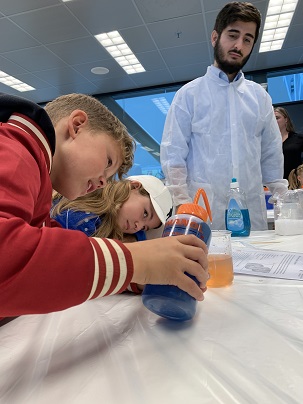Vision
Public engagement stands for social and public involvement. It describes the many ways in which the activities and benefits of higher education and research can be shared with a wide audience.

Engagement is by definition a ‘two-way street’, so it goes both ways. Anyone involved in education, research or other academic activities should be able to collaborate with public partners. These partners can vary from citizens, to communities, to (non-)governmental organizations. By interacting with and listening to the audience, this can be beneficial for both parties. Think of it as a meaningful dialogue between the public and science.
The main purposes of public engagement
Although public engagement is multifaceted, the University of Groningen identifies the following main goals:
Sharing
Inspire or inform people about the work of the University in an open and transparent way. Making research and education more accessible by fostering understanding and stimulating curiosity. And also to generate attention for important issues.
Consulting
Through direct contact with society and the public, the University and researchers can learn from the perspectives and values of others.
Responding
Actively identify and respond to societal needs, concerns, ideas and requests from the public.
Creating knowledge together
Collaborating with the public on research projects to create knowledge together.
Applying knowledge together
Collaborating with others in recurring forms to find out where research and education can make a difference and create impact.
Why public engagement is important for the University of Groningen
One of the University's greatest responsibilities is to contribute ideas on how best to tackle societal challenges. Public engagement has a connecting and important role in this. By connecting research and education at the University of Groningen with society, a positive social impact can be created.
Public engagement can ensure that:
- The quality of education and research will be strengthened. There will be more transparency and relevance with regard to research and education, along with a degree of accountability towards the public.
- Wider access to research and participation can emerge.
- In the long run, social changes will be promoted.
By allowing people to participate actively in the scientific process, more awareness and involvement can also be created on a social and scientific level.
What actions is the University of Groningen taking regarding public engagement
The University of Groningen has a long history of dedicated public engagement activities and will continue to provide its employees with optimal support in their initiatives in this area in the coming years. We are setting up a university-wide program that will facilitate employee involvement in society. The aim is to further embrace and integrate public engagement within the University of Groningen as an academic priority.
To achieve this, the University will focus on the following goals:
Professionalization
Services and departments that support public engagement will be further professionalized. Extra attention is paid to funding applications, as major funds have made strong public engagement programs an important condition for receiving financial grants.
Recognition and appreciation
Subsequent recognition and appreciation mechanisms will be introduced to motivate and reward employees who are actively engaged in public engagement.
Community
A public engagement community will be established to raise awareness and facilitate the exchange of information between initiatives.
Start-up funding
A request for start-up funding will be submitted, with the aim of identifying public questions and starting a collaborative project involving scientists, lecturers and students of the University of Groningen.
